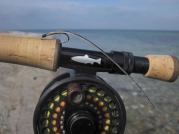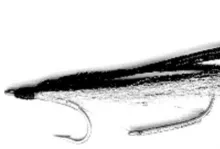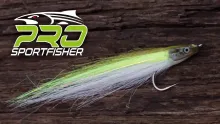Sand eels are very common in most waters around the world. This is a very simple flatwing style sand eel that can be tied easily with very few, common materials, and make a great imitaion that is easy to cast on a light rod.
Sand eels are very common in most waters around the world. When we take sea trout and gut them 8 out of 10 of the ones, which have anything in their stomach, have sand eels or similar small fish in their stomach. The sand eels here vary from an inch in length to about 10 for the really big ones. I'll stay in the smaller range and make a fly, which can be handled on a one hand rod in my favorite 5-7 weight range, and will imitate the smaller near-shore sand eels nicely.
I love flatwing flies and have done so ever since reading Ken Abrames' books Striper Moon and A Perfect Fish, and what we need here lends itself very nicely to this tying style.
I know that a flatwing is no novelty, and that these flies have been used for ages in many parts of the world, but many tiers haven't opened their eyes to this simple, yet beautiful way of constructing elongated baitfish imitations. I have decided to simplify my flatwing in order to keep to the Mundane manifesto, so this fly is simpler than your usual large flatwing.
I know that a flatwing is no novelty
The main part of the fly will be hackle feathers in a light gray color. You can use almost any medium quality saddle for this, as long as the feathers are slender and not too tapered. Any cheap, low grade dry fly saddle will be fine.
I will use the straight part of the feather for the "wing", and some of the fluffy stuff to form the "body" and give some volume. Not much, but enough to move some water.
I also want some shine, and I get that from simple flash. I simply add a bit in the wing. Talking wing and body is kind of a misnomer here since the feathers are supposed to form the whole body of the fish with some volume up front and a lot of movement in the full length, but that's how we name fly parts.
Finally I want that typical dark back of the sand eel, which in my eyes is superiorly obtained with peacock herl. This brilliant material has it all: shine, the right color, the length and the movement. And it's inexpensive and easy to find, so it a perfect mundane fly material.
This pattern is a part of The Mundane Fly Project, which aims to create really simple patterns with few common materials.
There will be more on the project as more patterns get published.
- Log in to post comments













Daniel,
Theoretic
Daniel,
Theoretically the fish could go for the "body" or the "tail" of the fly and miss the hook, but flatwings and US saltwater flies built on the same principle - short hook, long body - have worked well for ages and actually work well for seatrout too. This fly still has to lay down a serious track record before I stick my neck out 100% for it, but I'm pretty sure that it will do fine. My biggest issue is actually that the tail/body has a tendency to wrap around the hook if you don't cast it gently. I troll it most of the time from my pontoon boat, so casting isn't the big problem.
Martin
Nice and easy to tie
Nice and easy to tie! Going to make a couple of these today. Just curious if one hook alone is enough seeing as the fly is rather long. Won't that mean that there's a risk that the fish go for the body and completely miss the hook?
Nice fly. This fly s
Nice fly. This fly seems to be very similar to Sören Essebo's White Sara fly. Just replace hackle feathers by ostrich hearl. But thanks for good idea I will try it.